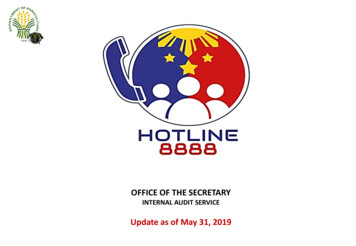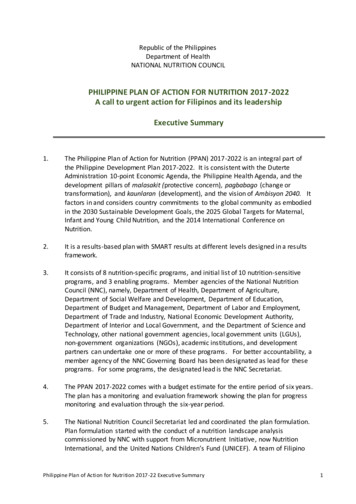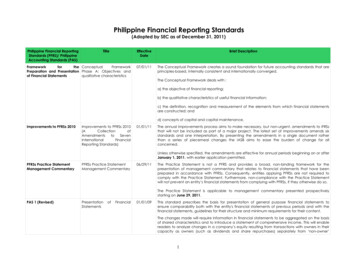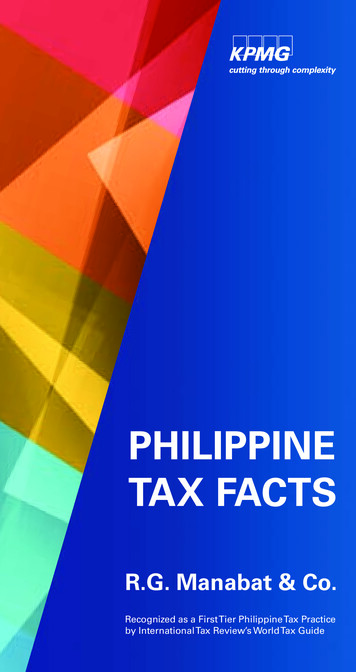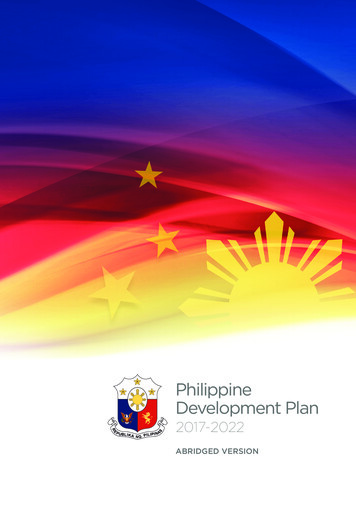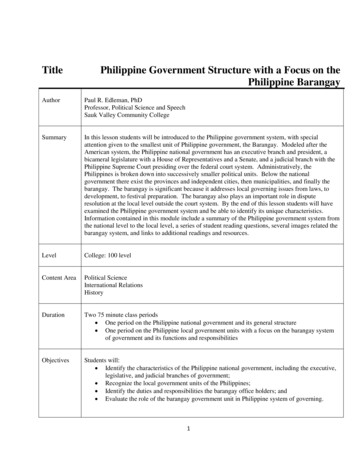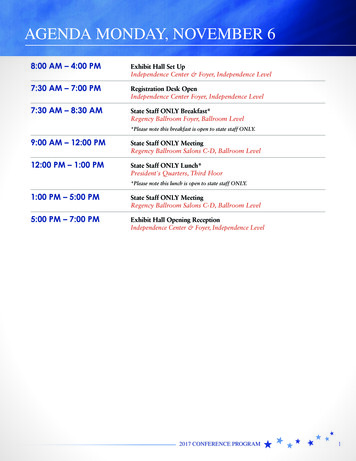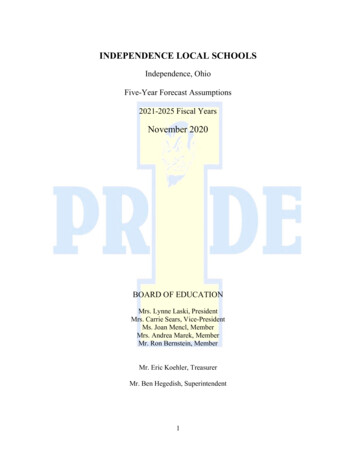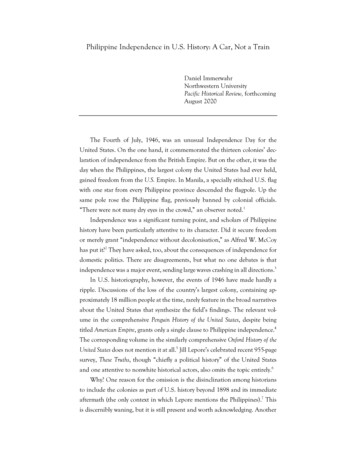
Transcription
Philippine Independence in U.S. History: A Car, Not a TrainDaniel ImmerwahrNorthwestern UniversityPacific Historical Review, forthcomingAugust 2020The Fourth of July, 1946, was an unusual Independence Day for theUnited States. On the one hand, it commemorated the thirteen colonies’ declaration of independence from the British Empire. But on the other, it was theday when the Philippines, the largest colony the United States had ever held,gained freedom from the U.S. Empire. In Manila, a specially stitched U.S. flagwith one star from every Philippine province descended the flagpole. Up thesame pole rose the Philippine flag, previously banned by colonial officials.“There were not many dry eyes in the crowd,” an observer noted.1Independence was a significant turning point, and scholars of Philippinehistory have been particularly attentive to its character. Did it secure freedomor merely grant “independence without decolonisation,” as Alfred W. McCoyhas put it?2 They have asked, too, about the consequences of independence fordomestic politics. There are disagreements, but what no one debates is thatindependence was a major event, sending large waves crashing in all directions.3In U.S. historiography, however, the events of 1946 have made hardly aripple. Discussions of the loss of the country’s largest colony, containing approximately 18 million people at the time, rarely feature in the broad narrativesabout the United States that synthesize the field’s findings. The relevant volume in the comprehensive Penguin History of the United States, despite beingtitled American Empire, grants only a single clause to Philippine independence.4The corresponding volume in the similarly comprehensive Oxford History of theUnited States does not mention it at all.5 Jill Lepore’s celebrated recent 955-pagesurvey, These Truths, though “chiefly a political history” of the United Statesand one attentive to nonwhite historical actors, also omits the topic entirely.6Why? One reason for the omission is the disinclination among historiansto include the colonies as part of U.S. history beyond 1898 and its immediateaftermath (the only context in which Lepore mentions the Philippines).7 Thisis discernibly waning, but it is still present and worth acknowledging. Another
Immerwahr Philippine Independence 2reason is the assumption that Philippine independence was foreordained. U.S.leaders had spoken for decades of eventually freeing the Philippines. In 1934,Congress passed the Philippine Independence Act, which “resolved the question of independence” by giving it a timetable, the historian Gary Hess haswritten.8 “All that remained was to organize the parades,” is how historian Elizabeth Cobbs Hoffman has characterized the post-1934 period.9 In this view,the colony’s receipt of independence in 1946, on exactly the planned date, doesnot seem surprising or noteworthy. It was a train arriving on schedule—a nonevent.In this article, I will reconsider Philippine independence as seen fromWashington, using archival evidence largely located there, and make two related arguments. First, the question of Philippine independence was not “resolved” by the 1930s—the promises made were not binding and, as it happened,the reasons why they were made were entirely different from the reasons whythey were kept. The right metaphor is not a train, following the rails of history,but a car, making a purposeful turn when it might not have. This argumentdiffers from most scholarship on the topic in that it asks not about the terms ofindependence—who won, who lost—but why it happened at all. The Philippines’ road to freedom, I will strive to show, was significantly more twisted thanhas been appreciated.My second argument is that the bare fact of independence, regardless of itsterms, was deeply consequential for the United States. Washington released itslargest colony in 1946 chiefly to position itself as a liberator in the GlobalSouth. Doing so bought the United States considerable international credibility, which in turn allowed it to broker a key compromise over empire duringthe establishment of the United Nations. More broadly, Philippine independence served as the enabling condition for the United States’ postwar approachto empire, the start of its own process of decolonization, and a central exhibitin the case for its legitimacy as a global hegemon.ACCORDING TO THEofficial story, Philippine freedom had always been thegoal. In his independence message, President Harry Truman described the eraof U.S. rule as “a period of almost fifty years of cooperation with the Philippineslooking toward independence.”10 In a way, he was right. Policymakers had spoken of independence from early on. The U.S. mission, as President TheodoreRoosevelt articulated it, was to help the Philippines “upward along the stonyand difficult path that leads to self-government.”11 This was the logic of tutelary
Immerwahr Philippine Independence 3colonialism, which justified empire as form of benevolence through which immature peoples—Woodrow Wilson called Filipinos “children” in political matters—were taught to rule themselves.12 It was not always clear whether “self-government” entailed full independence or just autonomy over internal affairs, butthe concept was not so loose as to be meaningless, and the Philippines wasmarked as a special colony, slated for freedom in a way that Hawai‘i, PuertoRico, and Guam were not.13Still, Filipinos had cause to wonder how firm the promises of freedomwere. When the nationalist Emilio Aguinaldo declared independence in 1898,Washington did not back him, as Aguinaldo had hoped and expected. Instead,the United States insisted on its own sovereignty and launched a bloody war ofpacification. That war lasted years and, it now seems, killed more people thanthe U.S. Civil War.14Another reason Filipinos might have doubted the promises of self-government is that their time-scales were often expansive. In 1901, Theodore Roosevelt mused that self-government had taken English-speaking peoples “morethan a thousand years” to achieve, and he believed “large portions” of the Filipino “race” to be “very far behind the point which our ancestors had reachedeven thirty generations ago.”15 Seven years later, Roosevelt’s successor WilliamHoward Taft, who had been the Philippine governor-general, judged it to be“quite unlikely that the people, because of the dense ignorance of 90 per cent.,will be ready for complete self-government and independence before two generations have passed.”16Roosevelt and Taft were Republicans, and as such envisioned a long imperial future. Democrats, less enamored of empire and more hostile to prolongedpolitical association with nonwhite peoples, proved willing to talk timelines.The Democratic Party platform in 1912, like previous platforms, denounced“the experiment in imperialism as an inexcusable blunder” and demanded an“immediate” declaration of U.S. intentions to free the islands.17 Woodrow Wilson won the 1912 election, becoming the first Democratic president to takeoffice since Philippine annexation, and he appeared to support his party’s position. “The Philippines are at present our frontier,” he said shortly after hiselection, “but I hope we presently are to deprive ourselves of that frontier.” Inhis first annual message to the U.S. Congress, he insisted that “we must holdsteadily in view” the Philippines’ “ultimate independence.”18In 1916, Wilson hesitantly supported a measure to set the colony on a fouryear countdown to independence. The “scuttling bill,” as the newspapers
Immerwahr Philippine Independence 4derisively called it, cleared the U.S. Senate by the slimmest of margins but ranaground in the House when thirty members of Wilson’s party rejected it. It wasa principled bill, the Detroit Free Press allowed, but its principles were those of“a man who, having agreed to protect and educate a child, tires of his bargain,turns the child out on the street on the plea that the child doesn’t like restraint,and leaves it to become the prey of white slavers, thieves, and murderers.”19 Inthe rejected bill’s place, Congress passed and Wilson signed a weaker and vaguer measure, the Jones Act, which declared it the intention of the UnitedStates to free the Philippines “as soon as a stable government can be established.”20 The critical term “stable government” went undefined, though.With Democrats divided, the issue subsided during the successive Republican administrations of the 1920s. It was the Depression that revived it. “Areversal of opinion is taking place concerning Philippine independence,” observed Calvin Coolidge in 1931.21 The reversal had little to do with new estimations of Philippine capacities. Rather, the chief issues were trade and labor.The Philippines had enjoyed largely tariff-free trade with the mainland since1909, and no laws prevented Filipinos from migrating there, as more than45,000 had done.22 Yet once the mainland economy faltered, beet farmers (whohad to compete with Philippine sugar), West Coast labor unions, and otheragricultural interests lobbied for Philippine independence. By redrawing theircountry’s borders, they hoped to make the Philippines foreign, locking out itsworkers and produce.The historian Paul Kramer has rightly warned against interpreting this independence push as an “early act of decolonization.”23 Congressional deliberations were inward-looking—concerned with fortifying the mainland against external threats—and featured few of the outward-looking concerns that wouldcharacterize the postwar liberation of colonies worldwide. The political scientist Thomas Pepinsky has argued this point persuasively. Had the push for Philippine independence been about dismantling the U.S. Empire or empires ingeneral, Pepinsky argues, Congress would probably have seriously pursued Hawaiian and Puerto Rican independence as well. But it did not, and the reasonis that mainlanders largely owned the sugar plantations in those two territories,whereas in the Philippines the relevant agricultural enterprises were more oftenowned by Filipinos or foreigners, who had less clout in Washington. This madethe Philippines an easy target for the beet- and cotton-growing states, whichsought to avoid competition from Philippine-grown sugar, coconut, and hemp.Pepinsky shows that these states, especially the beet-growing ones, were
Immerwahr Philippine Independence 5irrespective of party the ones particularly inclined to back Philippine independence.24 “We are not here to-day talking about the liberty and freedom of theFilipinos,” one senator sighed. “We are not interested in the independence ofthe Philippines. We are interested in the financial and selfish economic interestof the United States.”25At a House hearing, Manuel Roxas, the future Philippine president, suggested that independence might shine “a ray of hope” into the hearts of themillions in Asia “struggling for their own liberty.”26 Few U.S. congressmen sawit that way, though. What is striking is how rarely they invoked internationalpolitics. The threat from Japan was mentioned—it made the Philippines a “sorethumb,” one representative insisted, that would cause “trouble if any unpleasantness comes in the Pacific Ocean.”27 But there was little sense that Philippineindependence would be an opening shot in a global liberation campaign. Theprevailing spirit was expressed not by Roxas but the president of the NationalBeet Growers Association: “I believe it is time for the United States to stopacting as a good cousin or a good brother to the whole world, and that theUnited States ought to stay at home and attend to its own business.”28“I want our people to keep out of the Orient and I want the Orient to keepout of the United States,” a U.S. senator insisted—the racist overtones werehard to miss.29 “Let’s get rid of the Philippines,” is how FDR made the case tocongressional leaders.30 This was a desire less to achieve independence for thePhilippines than to achieve it from the Philippines, as the Philippine Legislaturetartly observed.31 It was an abandonment of the tutelary colonialism that hadanimated early U.S. imperial rule in exchange for an exclusionary bigotry thatsought simply to cast out a people understood as foreign.32The push for Philippine independence, fueled more by lobbying than loftyprinciples, garnered scant support from the Republican-leaning mainlandpress. “It would be a mortifying spectacle to see the United States readjust itsPhilippine policy to fit the balance sheets of a select group of industrial andagricultural interests,” admonished the Christian Science Monitor.33 A survey ofnearly three hundred major mainland newspapers in 1931–32 found 92% ofthem against it, including the New York Times, Wall Street Journal, Chicago DailyTribune, and San Francisco Chronicle.34Even in Manila, there was hesitation. Manuel Quezon, head of the Nacionalista party and president of the Philippine Senate, had made his reputation bycalling for independence, yet he also understood the dangers that separatingfrom the United States might bring. The Philippines had no military capable
Immerwahr Philippine Independence 6of fending off a foreign invasion, and about four-fifths of its trade by the 1930swent to the U.S. mainland. The sudden loss of U.S. military protection andtariff-free access to mainland markets would be catastrophic.In the past, Quezon had squared the circle by publicly demanding independence while privately assuring his Washington contacts that this was justempty talk—Quezon’s resistance was one reason why the independence bill in1916 failed. But that ploy only worked so long as the U.S. Congress kept itsgrip on the Philippines tight. Once mainlanders saw the Philippines as a burden and started seriously talking independence, Quezon could no longer playgood cop to Washington’s bad cop. After a bill for Philippine independencepassed through the U.S. Congress—over a veto from President Hoover—in1933, a panicked Quezon had it blocked in the Philippine Legislature. But thiswas not, ultimately, a tenable stance for the head of the nationalist party. Andso, when a similar bill passed in 1934, it did so with Quezon’s blessing and wasratified unanimously in the Philippine Legislature.35THE PHILIPPINE INDEPENDENCE ACT,known also as the Tydings-McDuffieAct, became law in March 1934. Once Philippine legislators wrote a constitution that the U.S. president approved and Filipinos accepted, the Philippineswould become a “commonwealth”—a British category indicating a territory withsome internal autonomy. Ten years after that, the colony would be free.“If this is accomplished without complications,” wrote the historian Samuel Flagg Bemis, “it will bring to an end the great aberration of 1898.”36 Bemis’scaution about “complications” is worth noting. The Philippine IndependenceAct provided not certainty but a promise, and promises had been made before.The 1916 Jones Act had promised independence once the Philippines had a“stable government.” Yet although the colony had “succeeded in maintaininga stable government,” as Woodrow Wilson told the U.S. Congress in 1920,and therefore had “fulfilled the condition” set by legislators for independence,nothing had happened.37 Not only was the 1916 pledge not honored, it wassuperseded and rendered void by the new independence act. Ominously, that1934 act referred to independence in conditional terms—“if and when the Philippine independence shall have been achieved.” A possibility, in other words,not an eventuality.There were many potential hitches. As the U.S. Congress had never beforedeannexed territory, there was a question about whether it had the power to—the Constitution said nothing about this and congressmen were unsure.38
Immerwahr Philippine Independence 7What if the Supreme Court, then dominated by Republican appointees, ruledthe independence act unconstitutional? Or what if future legislators amendedor rescinded it, as they had done with the 1916 Jones Act? The conjuncture ofindependence-favoring Democrats and economic depression was likely a transient one, which would fall apart if either prosperity returned or the Republicans did. “If we wait 12 years for the so called ‘fixed date,’” the University ofthe Philippines’ president warned, “in all probability the Republicans will beback in power . . . and they will indefinitely postpone our independence.”39Certainly, any politician seeking to retain the Philippines would have had thepress’s support.The Supreme Court and Congress could halt independence. Could theWhite House? The Philippine Independence Act gave the U.S. president threeveto points. First, he had to approve the commonwealth constitution beforethe ten-year countdown would start. Then, once it was underway, the independence act secured an unrestricted presidential “right to intervene” in the commonwealth to preserve the Philippine government; to protect life, property,and liberty; or to ensure that the Philippines would be in a position to assumethe debts owed by the colonial government to bondholders (who were overwhelmingly mainlanders).40 This right to intervene was modeled on the notorious Platt Amendment, which had licensed U.S. interference in independentCuba for the “protection of life, property, and individual liberty” (the samephrase appeared in the Philippine Independence Act) and resulted in Washington sending troops there four times.41 Finally, even if the commonwealthconstitution was approved and the government operated smoothly for tenyears, independence was not automatic. It required a presidential proclamation, and the independence act provided no recourse if the president refusedto issue one.The Philippines was to be kept on a tight leash, in other words. To holdthe tether, the independence act mandated that a high commissioner be postedin Manila to monitor the new government—to “observe and report directly tothe President any matter which indicates the Commonwealth Government’sinability or failure to reach full statehood,” as one high-ranking official put it.42It was not hard to imagine a scenario in which the Philippine commonwealthwould “fail to reach full statehood” in Washington’s eyes. The countdown period to independence would inevitably be a tumultuous time—rapid politicalchange, rapid economic change (the independence act cut off Filipino migration to the mainland and gradually raised mainland tariff walls), and a looming
Immerwahr Philippine Independence 8threat of war from Japan. Any of these could easily destabilize the colonyenough to prompt a reconsideration of independence.THESE WERE ABSTRACTworries, yet they became concrete quickly. Two weeksbefore the Philippine plebiscite in May 1935 that would bring the commonwealth government into existence, thousands of peasants and workers in at leastfifteen towns and villages staged an uprising: the Sakdal Rebellion. Shouting“Mabuhay ang Republika Filipina” (Long Live the Philippine Republic), theycut telegraph wires, blocked roads and rail lines, seized government buildings,and tore down the U.S. flag. The Sakdalistas, impatient with the Philippineelite’s temporizing, demanded immediate independence. Their leader, BenignoRamos, doubting the United States would set the Philippines free in ten yearsas promised, had called for violent revolution. The uprising lasted for two days,during which police killed 59 rebels. It was the most serious revolt in the U.S.Empire since the Philippine War.43Sakdalistas rejected the Philippine Independence Act. Many elite Filipinosand colonial officials shared that discontent, though for different reasons. Dissenting murmurs came first from sugar planters who, afraid of losing lucrativemainland markets, launched a “reexamination movement” that gained adherents in the Philippine Assembly. Another serious worry was Japan, which in1937 widened its war within China. Should the Japanese press south, the Philippines would probably fall in their path. Washington was obliged to protectits colony while the Philippines was still U.S. territory, but what if it were aforeign country? Theodore Roosevelt Jr., the former governor general, shedlight on the issue. “As a matter of cold actuality,” he explained to Manuel Quezon after Quezon’s inauguration as the new commonwealth’s president, “theAmerican people will not jeopardize their interest in the future for an independent Philippines any more than they will for any other nation, and mostcertainly would not engage in a war on their behalf unless the real interests ofthe United States were involved.”44By 1937, Theodore Roosevelt Jr. had concluded that independence was amistake. By 1938, the high commissioner, Paul McNutt, agreed. “If our flagcomes down, the Philippines will become a bloody ground,” he predicted in aradio broadcast in which he called for a “realistic reexamination” of the independence act.45 For the colony’s highest-ranking official to disavow independence was bold, but McNutt felt the wind of change at his back: “Congressthinks we are on our way out, apparently. But the American people are sure to
Immerwahr Philippine Independence 9realize that the situation has changed entirely recently.”46 Historian MeganBlack describes a “chorus of voices”—military officers, investors—demanding repeal of the independence act once it became clear that the Philippines possessed minerals of strategic value the coming war.47 A Gallup poll at the timeshowed 76 percent of mainlanders opposed immediate independence.48Publicly, most Filipino politicians rejected McNutt’s call to reconsider independence. Yet a State Department memo reported it to be “generally understood that a great many important figures in Philippine political, business, andprofessional life” were “covertly sympathetic” to the reexamination movement.49 For Manuel Quezon, the sympathy was overt. He pronouncedMcNutt’s “presentation of the facts” to be “unassailable.”50Quezon quickly took it back. As the leading Nacionalista, he could notcredibly side with McNutt and ask Washington to rescind its independencepromise. Still, he saw the peril his country faced. He made secret overtures toJapan, building on a longstanding Philippine-Japanese ties.51 He quietly approached the British about annexing the Philippines if the United States abandoned it.52 Most importantly of all, he began to hastily build a national defenseforce capable of repelling a Japanese invasion.To build his army, Quezon recruited General Douglas MacArthur, one ofthe few high-ranking U.S. officials with strong ties to the colony—his father,Arthur MacArthur, had been governor. So committed was Douglas MacArthurto Philippine defense that he resigned his generalship in the U.S. Army to serveas field marshal of the Philippine commonwealth. But even MacArthur, architect of the Philippines’ autonomous defense force, opposed independence andwas unsure if it would take place. “We may be there ten years—we may even bethere indefinitely,” he wrote shortly after the Philippine Independence Actpassed.53BY THE LATE1930s, Philippine independence was a wobbly proposition: topcolonial officials had turned against it, there was little mainland public support,and many Filipino leaders were also opposed, at least privately. The PhilippineIndependence Act had promised freedom, but that promise was riddled withloopholes.The wobbles became fully seismic in December 1941, when Japan invaded.Militarily, it was a rout. Japanese forces overran the archipelago, and MacArthur and Quezon retreated, along with the top layer of the commonwealth government, to the island fortress of Corregidor. From there, Quezon demanded
Immerwahr Philippine Independence 10immediate independence. He wanted to declare neutrality—something he couldnot do while under U.S. sovereignty—and negotiate to have both the UnitedStates and Japan withdraw their forces. MacArthur endorsed this idea, but Roosevelt refused. “You have no authority to communicate with the Japanese government,” he scolded Quezon.54Military prospects worsened, and in March 1942 Roosevelt ordered Quezon, MacArthur, and other top officials out. The commonwealth governmentwould henceforth operate in exile. Japan, blaring propaganda about an Asiafree from white rule, promised liberation and indeed formally granted it to thePhilippines in 1943. Yet Japan’s lofty rhetoric was undercut by the occupation’sbrutality. To feed its war machine, Japan ransacked the Philippine economyand forcibly repressed the populace.In 1944, MacArthur returned to reclaim the islands, and the resulting fightturned the Philippines into a Pacific bloodlands. Japanese troops dug in, butchering Filipinos. U.S. forces destroyed buildings that might shelter the enemy,with little regard for those caught in the crossfire (“It was United States bombsand shells that did most of the damage,” lamented the New York Times).55 Manila saw around 100,000 of its residents killed in a single month in 1945—Dwight Eisenhower declared it worse than anything he had seen in Europe saveWarsaw.56 The Philippine government recorded 1,111,938 Filipino fatalities inthe war.57 Many had died during the furious fight to “liberate” the colony.The Legislative Building, a seat of the commonwealth government, after being shelled by the U.S.Army’s 37th Infantry Division (American Historical Collection, Ateneo de Manila)The Philippines was wrecked—“without question the most completely destroyed and dislocated battle ground of the war,” in the words of High
Immerwahr Philippine Independence 11Commissioner McNutt.58 U.S. Senator Millard Tydings, one of the PhilippineIndependence Act’s authors, estimated that 10 to 15 percent of the territory’sbuildings had been destroyed and another 10 percent damaged.59 Industry andagriculture had virtually halted. The government, banks, and insurance companies were insolvent, inflation ran rampant, and a shipping logjam threatenedto cut off much-needed food imports.There were political problems, too. Most Filipino politicians remaining inthe territory during the war had served Japan’s government. Meanwhile, manypeasants had joined anti-Japanese guerrilla armies, armies which had begun asocial revolution by redistributing landlords’ estates. Filipinos had not justfought the Japanese during the war, in other words; they had fought each other,and they were poised to keep fighting.In principle, Washington sought to purge the collaborators from government, but this was not easily done. Who had collaborated willingly, who reluctantly? The waters were particularly murky around Manuel Roxas, a former aideto MacArthur. Roxas had held a cabinet position in the Japanese-backed government and was “undoubtedly seriously involved” with Japan, according tothe U.S. consul general. But, the consul general continued, he had “played safeby helping both sides.”60For MacArthur, that sufficed. “Roxas is no collaborationist,” he declared,but was one of the “prime factors” in the resistance movement.61 Acting swiftly,MacArthur exonerated his former aide and reconvened the Philippine Assembly, even though many of its members had worked with Japan. Those legislatorsthen voted Roxas senate president. “Not a single senator can be justly accusedof collaboration!” he declared in the senate to great applause.62 With some ofthe most powerful elements in Philippine society behind him, including thosewho had served Japan, Manuel Roxas was a clear contender for president.63IT IS USEFULto step back and assess these events in full. The Philippine Inde-pendence Act had provisionally promised independence, but that promise hadbeen predicated on the commonwealth regime protecting life and property anddemonstrating its ability to repay mainland bondholders. Should the commonwealth government fail to perform, there were multiple ways that Washingtoncould cancel Philippine independence: by a new law, by a Supreme Court ruling, or by presidential refusal.Moreover, by the scheduled independence date in 1946, the war hadwholly derailed the envisioned preparations. Had the commonwealth
Immerwahr Philippine Independence 12government protected life and property? Absolutely not. It had been forced intoexile, watching from afar as more than a million of its people were killed andmore than 10 percent of buildings were destroyed. Could it take over thebonded debt—a subject of grave concern to the authors of the Philippine Independence Act? No, it could not, and given the war’s economic toll it would beyears before bond repayment would be remotely possible.64Not only were the preconditions for independence conspicuously unmet,the underlying logic had changed drastically. In the 1930s, the U.S. Congresshad scheduled its colony for independence chiefly to shield the mainland fromPhilippine produce and labor—a threat often expressed in terms of nativist racism—and to relieve it of the obligation to defend a vulnerable Asian territory.Yet the war had systematically removed those motives. Economically, the mainland was now booming and the war-shattered Philippines posed no threat. Justthe opposite: Philippine trade was now more desirable than ever as the interwarsugar glut had given way to a postwar sugar shortage.65 Militarily, the situationhad also reversed. With Japan defeated and U.S. strategic interest in Asia growing, the Philippines was no longer a military liability but an asset. High Commissioner McNutt described the territory as an “instrument for the maintenance of the peace of the Orient and the world,” and Washington would soonpush for 99-year leases on Philippine base sites.66 Even the cultural logic hadshifted. The exclusionary racism that suffused 1930s debates over independence had been seriously challenged by the war. Numerous wartime Hollywoodfilms depicted Filipinos with sympathy and even heroism.67 And the Luce-Celler Act, passed by Congress t
Philippine Independence in U.S. History: A Car, Not a Train Daniel Immerwahr Northwestern University Pacific Historical Review, forthcoming August 2020 The Fourth of July, 1946, was an unusual Independence Day for the United States. . prevailing spirit was expressed not by Roxas but the president of the National Beet Growers Association: "I .

